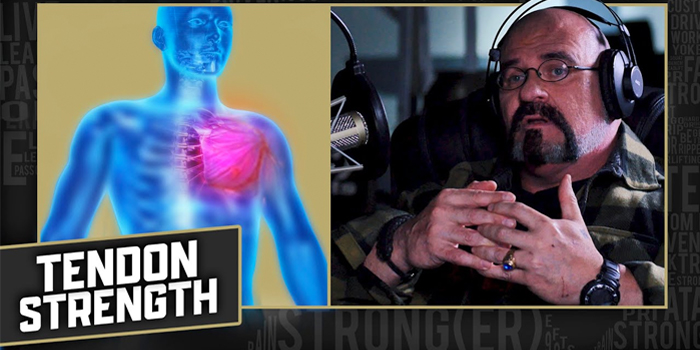
What did Dave Tate and JM Blakley do for tendon strength?
Dave Tate didn’t pay attention to tendon strength until his pec tendon popped off of his shoulder and he lost the ability to move his arm. Then he started caring a whole lot. Once he was totally healthy, the first thing he did was ultra-high reps trying to use the least amount of muscle force as possible. For example, for his pec, he would do a high rep, reverse band bench press where it is essentially zero pounds of weight at his chest for 100 reps. The first time his triceps would burn at around 60 reps. That means that he was using too much muscular force. If he was feeling a burn in his triceps, that meant there was blood that wasn’t going towards the tendon. He had to push with only a couple of pounds necessary to be able to get one hundred reps. Getting the blood to go into your tendons and not your muscles if very tricky, so you must deliberately try to apply little muscular force and just go through the range of motion.
When strengthening his elbows, he would do even higher reps on band tricep pushdowns. Often performing these for 100 reps, he would push up towards even 150 or 200 reps. Still, he wouldn’t have any soreness the next day. If you are getting sore from this you are applying too much muscular force. If you pushed as lightly as possible and didn’t resist the eccentric at all you could focus solely on getting blood into tendons, not your muscles.
Dave’s third exercise for tendon strength is overcoming isometrics for 3-5 second pulses with no weight. To make sure he still trained his full range of motion he would move the pins up or down every 15 degrees of the joint angle so he strengthened his tendons in all positions. As he got closer to the meet, he started to pull these out of his training. When he was close to competition, the stress of the isometric work wouldn’t be worth including, so he would pull it out and use something less intensive like the band pushdowns. He would also not try to progress in weight on these exercises. With the difficulty of getting the blood in the tendon and not the muscle, adding extra weight or more band tension only made it harder to keep the focus where he wanted it.
Close to the competition he would just focus on not gaining large amounts of weight too fast. Bloating up 25 pounds in one day would be unnecessary and changes your leverages too much, both externally and internally, that you would be at a higher risk of a lift going wrong or tearing something.
JM has his own methods here. He thinks the heavy loads will build your tendon strength just fine on their own. Wolffs Law of Bone says that bone that has high loads placed upon will remodel to become stronger and more resistant to heavy loading. After lifting heavy weights or doing other high impact exercises like running or jumping, your bones will grow thicker where the stress was placed. However, this is true for other connective tissues like tendons and cartilage. If your tendons are feeling beat up, you’ve just applied too much stress to them and they are yet to remodel stronger. When progressively overloading with heavy weights, the tendons will adapt and grow stronger. Being in tune with your body and listening to your joints if they start hurting is key.
Your tendons also have a specific sensory organ in them, called the Golgi tendon organ. The Golgi tendon organ or GTO measures tension in your muscle fibers. When rapidly loaded, it triggers the Golgi tendon reflex or “stretch reflex” to push back even harder. If overloaded too much, it triggers the inverse myotatic reflex, which is the opposite of the stretch reflex. If rapidly overloaded, the GTO will simply cease all force output in your muscle as an attempt to save your muscles from being damaged. If in the middle of a lift, you will just drop the weights and collapse instantly without even thinking about it. This happens because it is a reflex, meaning the nervous system response doesn’t even get sent to the brain. The signal reaches the spine and instantly receives a message back to the muscles to stop contracting.
JM does have one special exercise for his tendons. There was once a period where the inflatable Swiss balls first made their way into Westside Barbell. JM would grab heavy dumbbells and set up to bench press off of the Swiss balls. After hammering out a high rep set to pre-fatigue his muscles, JM would relax into the bottom position of his dumbbell bench, but he stayed there. After two or three minutes hanging out at the bottom of a bench position, your muscles become so fatigued they have no choice but to totally load all your tendons in the fully stretched position.
Text By Mason Nowak









